engine coolant AUDI TT COUPE 2016 Owners Manual
[x] Cancel search | Manufacturer: AUDI, Model Year: 2016, Model line: TT COUPE, Model: AUDI TT COUPE 2016Pages: 322, PDF Size: 52.86 MB
Page 10 of 322
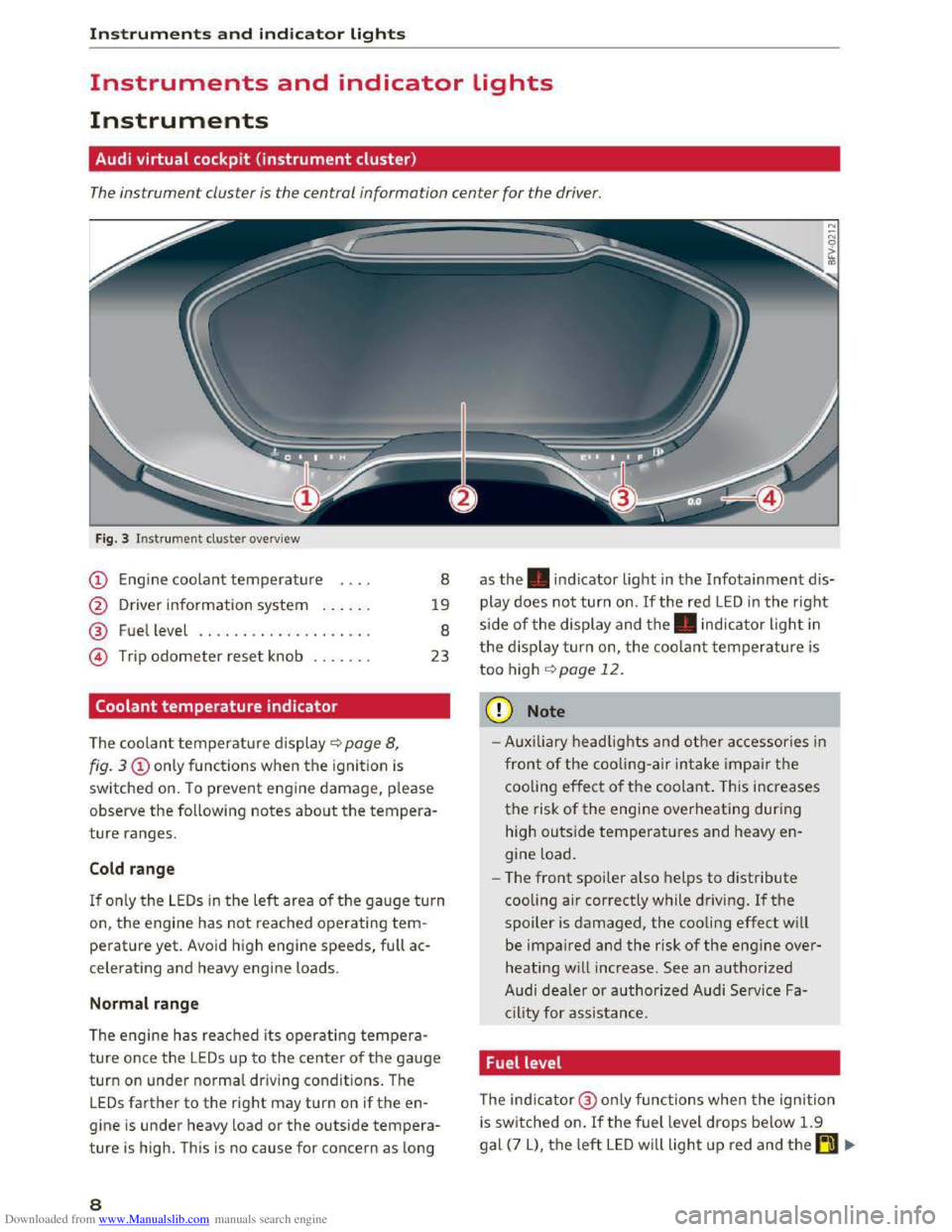
Downloaded from www.Manualslib.com manuals search engine Instruments and indicator lights
Instruments and indicator Lights
Instruments
Audi virtual cockpit (instrument cluster)
The instrument cluster is the central information center for the driver.
Fig. 3 Instrument cluster overview
(!) Engine coolant temperature
@ Driver information system ..... .
@ Fuel level .. ................. .
@ Trip odometer reset knob ...... .
Coolant temperature indicator
The coolan t temperature display~ page 8,
8
19
8
23
fig. 3 (!)only functions when the ignition is
switched
on. T o prevent engine damage, please
observe the following notes about the tempera
ture ranges.
Cold range
If o nly the LEDs in the left area of the gauge turn
on, the engine has not reached operating tem
perature yet. Avoid high engine speeds, full ac
celerating and heavy engine loads.
Normal range
The engine has reached its operating tempera
ture once the LEDs up to the center of the gauge
turn on under normal driving conditions . The
LEDs farther to the right may turn on if the en
gine is under heavy load or the outside tempera
ture is high. This is no cause for concern as long
8
as the. indicator light in the Infotainment dis
play does not turn on. If the red LED in the rig ht
s ide of the display and the. indicator light in
the d isplay turn on, the coolant temperature is
too high ~page 12.
CD Note
-Auxi lia ry headlights and other ac cessories in
front of the cooling-air intake impair th e
cooling
effect o f the coolant. T his increases
the risk of the engine overheating during
high
outside temperatures and heavy en
gine load.
- T
he front spoiler also helps to distribute
cooling air correctly while driving. If the
spoiler is damaged, the cooling effect will
be impaired and the risk of the engine over
heating will increase . See an authorized
Audi dealer or authorized Audi Service Fa
c ility
for assist ance.
Fuel level
The indicator@ only funct ions when the ignition
i s sw i
tched on. If the fuel level drops below 1.9
gal (7 L), the left LED will light up red and the~ .,.
Page 14 of 322

Downloaded from www.Manualslib.com manuals search engine Instruments and indicator lights
PARK/(®l/~ Electromechanical parking
brake
If the -(USA models) I. (Canada models)
indicator light turns on, the parking brake was
set.
-(USA models) /. (Canad a models) Park
ing brake: caution! Vehicle parked t o o steep
If the indicator light blinks and the message ap
pears, there is not enough braking power to se
cure
the vehicle. The brakes have overheated. The
vehicle could roll away even on a
small incline .
-
(USA mode ls) I. (Canada models)
Please press brake p edal to re lease parking
brake
T o release the park ing brake, press the brake
pedal and press the Iii button at the same time,
or start driving with hill start assist¢ page 62,
Starting from a stop.
llJ Parking brake: malfunction! See owner's
manual
There is a malfunction in the parking brake. Drive
to an authorized Audi dealer or authorized Audi
Service Facility
immediately to have the malfunc
tion corrected.
Im Parking brake: malfunction! Safe ly stop ve
hicle . Please contact Service
There is a malfunction
in the parking brake. Drive
to an authorized Audi dealer or authorized Audi
Serv ice Facility i
mmediately to have the malfunc
tion corr
ected.
llJ;!:t:)jJJJ~ (USA models) I Im (Canada models)
Please release parking brake.
Release the parking brake if this message ap
pears.
!f1;!:t:l;fJJj (USA mod els) I K@j (Canada models)
Park ing brake auto release unavailable
If this message appears, press the brake pedal
first and then release the parking brake.
llJ;!:t:)j(13~ (USA models) I Im (Can ad a models)
Parking brake: caution! V ehicle parked too
steep
12
If the indicator light blinks and the message ap
pears, there is not enough braking power to se
cure
the vehicle. The brakes have overheated. The
vehicle could roll away even on a
small incline.
11;1;!:t:ljtJ:O ( U SA models) I [@j (C anada models)
Park in g brake: applied
If this message appears, press the brake pedal
first and then release the parking brake if neces
sary.
(D Tips
For additional information on the parking
b rake,
refer to ¢page 61.
- L Cooling syste m
• Turn off engine and check coolant level
T he coo l
ant level is too low.
Do not continue driving and switch the engine
off. Check the coolant level ¢ page 242.
-If the coolant level is too low, add coolant
¢page 242. Only continue driving once the in
dicator light turns off.
• Coolant temperature: too high. Let eng ine
run with vehicle stationary
Let the engine run at idle for a few minutes to
cool off, until the indicator light turns off.
-
If the indicator light does not turn off, do not
conti nue driving the vehicle. See an authorized
Audi dealer or authorized Audi Service Facility
for assistance.
A WARNING
[.=-
-Never open the hood if you can see or hear
steam or coolant escaping from the engine
compartment. This increases the risk of
burns. Wait until you no longer see or hear
steam or coolant escaping.
- The
engine compartment in any vehicle can
be a
dangerous area. Stop the engine and
allow it to cool before working in the engine
compartment. Always follow the informa
tion found in ¢page 236, Working in the
engine compartment.
Page 61 of 322
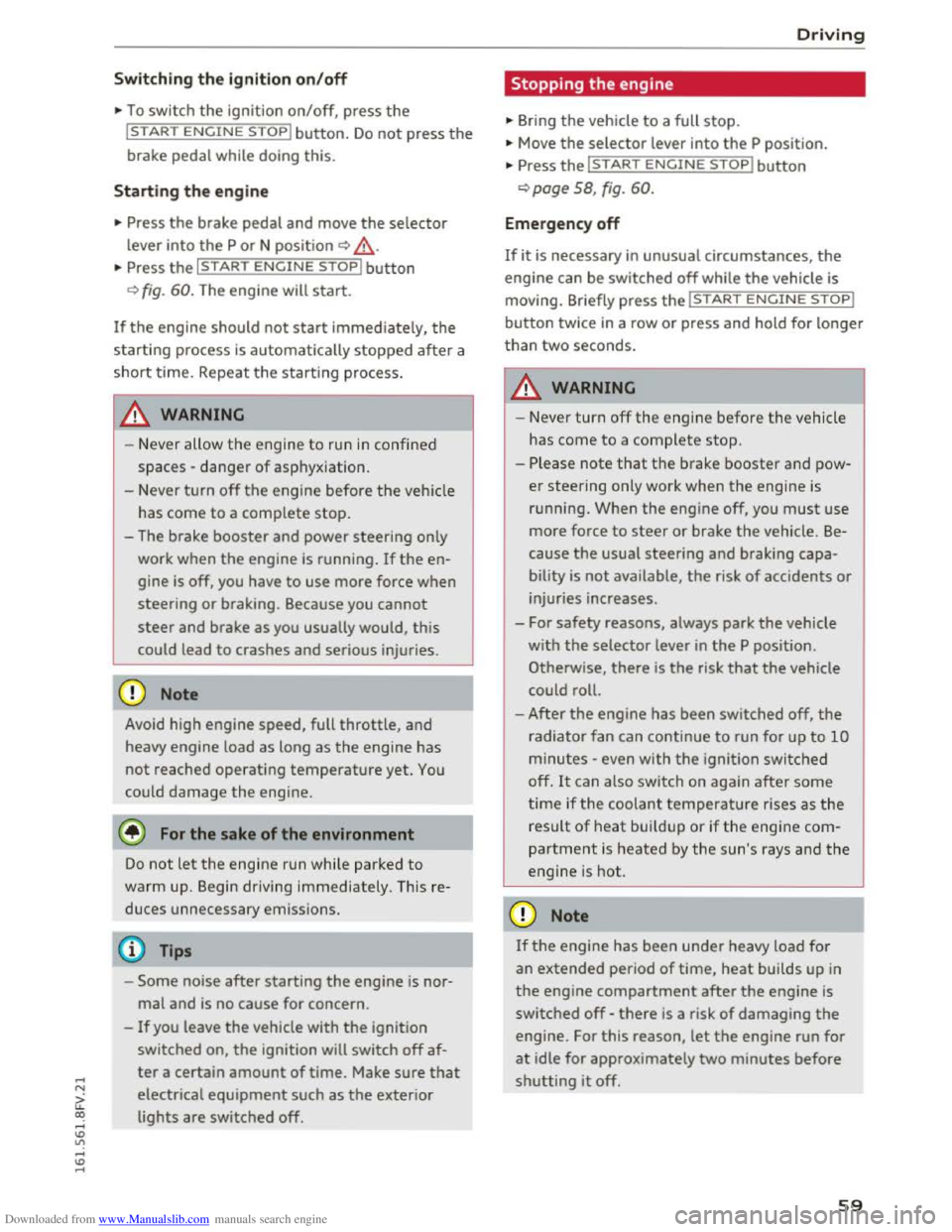
Downloaded from www.Manualslib.com manuals search engine ...... N
G'. CX)
..... ID VI ..... ID .....
Switching the ignit ion on/off
""To switch the ignition on/off, press the
I START ENGINE STOPI button. Do not press the
brake pedal while doing this.
Starting the engine
"" Press the brake pedal and move the selector
lever
into the P or N position~.&_.
... Press the I START ENGINE STOPI button
~fig. 60. The engine will start.
If the engine should not start immediately, the
starting process is automatically stopped after a
short time. Repeat
the starting process.
.&. WARNING
-I
-Never allow the engine to run in confined
spaces -danger
of asp hyxia tion.
- Never
turn off the engine before the vehicle
has come to a complete stop.
- The brake booster and power steering only
work when
the engine is running. If the en
gine
is off, you have to use more force when
steering
or braking. Because you cannot
steer and brake
as you usually would, this
could lead to crashes and serious injuries.
CD Note
Avoid high engine speed, full throttle, and
heavy engine load
as long as the engine has
not reached operating temperature yet. You
could damage the engine.
@ For the sake of the environment
Do not let the engine run while parked to
warm up. Begin driving immediately. This re
duces unnecessary emission
s.
Tips
-Some noise after starting the engine is nor
mal and is no cause for concern.
-
If you leave the vehicle with the ignition
switched on,
the ignition will switch off af
ter a certain amount of time. Make sure that
electrical equipment such as the exterior
lights are switched off.
Driving
Stopping the engine
... Bring the vehicle to a full stop.
""Move the selector lever into the P position.
... Press the I START ENGINE STOPI button
~page 58, fig. 60.
Emergency off
If it is necessary in unusual circumstances, the
eng i
ne can be switched off while the vehicle is
moving. Briefly press the I START ENGINE STOPI
button twice in a row or press and hold for longer
than
two seconds.
.&. WARNING
!-='
- Never turn off the eng ine before the vehicle
has come to a complete stop.
-
Please note that the brake booster and pow
er steering
only work when the engine is
r unn ing. When
the engine off, you must use
more force
to steer or brake the vehicle. Be
cause the usual steering and braking capa
bility is not available, the risk of accidents or
injuries increases.
- For safety reasons, always park
the vehicle
with the selector lever in the P position.
Otherwise, there
is the risk that the vehicle
could roll.
-
After the engine has been switched off, the
radiator fan can continue to run for up to 10
minutes -even with the ignition switched
off. It can also switch on again after some
time if the coolant temperature rises as the
result of heat buildup or ifthe eng ine com
partment is heated by the sun's rays and the
engine is hot.
CD Note
If the engine has been under heavy load for
an extended period of time, heat builds up in
the engine compartment after the engine is
switched off -there is a risk of damaging the
engine. For this reason, let the engine run for
at idle for approximately two minutes before
shutting it off.
59
Page 238 of 322

Downloaded from www.Manualslib.com manuals search engine Checking and Filling
function of the emission control system
and could lead to damage.
@ For the sake of the environment
Even when the Emission Control System is op
erating properly, the exhaust gas can have a
sulfur-like
exhaust gas smell under some op
erating states. This depends on the sulfur
content of the fuel being used. Using a differ
ent brand of fuel may help, or filling the tank
with lead-free super grade gasoline.
Engine compartment
Working in the engine compartment
Special care is required if you are working in the
engine compartment
For work in the engine compartment such as
checking and filling fluids, there is a risk of in
jury, scald ing , accidents, and burns. For this
reason, follow all the following listed warnings
and general safety precautions. The engine
compartment is a dangerous area. ~ & .
I'
A WARNING
-Turn the engine off.
-switch the ignition off.
-
Set the parking brake.
-
Place the selector lever in the P position.
- Let
the engine cool down.
- Never
open the hood when you see that
steam or coolant drips from the engine
compartment-there is a danger of burns!
Wait unti l no steam or coolant flows out.
- Keep children away from the engine com
partment.
- Never spill fluids on a hot engine. These flu
ids (such
as the freeze protection contained
in the coolant) can catch fire.
- Avoid
short circuits in the electrical system,
especially the battery.
-When working in the engine compartment,
remember that the radiator fan can switch
on even
if the ignition is switched off, which
increases
the risk of personal injury.
236
- Never open the cap on the coolant expan
sion
tank when the engine is warm. The
cooling
system is under pressure.
-To protect your face, hands, and arms from
hot steam or coolant, cover the cap with a
large cloth when opening.
-Do not remove the engine cover under any
circumstances. This increases the risk of
burns.
-
If tests need to be performed with the en
gine running, there is additional danger due
to moving components (such as the ribbed
belt, alternator and radiator fan) and from
the high voltage ignition system.
-Do not under any circumstances give gas in
advertently (for example, by hand from the
engine compartment) if the vehicle is sta
tionary but the engine is running and a gear
is engaged. Otherwise the veh icle will start
to move immediately and could result in a
crash.
-
Pay attention to the following warnings list
ed when work on the fuel system or on the
electrical equipment is required.
- Always
disconnect the vehicle battery
from the vehicle electrical system.
-Do not smoke.
-Never work near open flames.
-Always have a working fire extinguisher
nearby
- To reduce
the risk of electric shock and in
jury, never
touch the follow ing components
when t he engine is running or is being start
ed:
- Ignition cable
-
Other components in the electronic high
voltage ignition system
-If you must check or perform work on the
engine while it is running:
-
Set the parking brake and place the selec
tor lever in the P (park) position first.
- Always
proceed with extreme caution so
that clothing, jewelry or long hair do not
become caught in the radiator fan, fan
belt or other moving components or do
not come into contact with hot compo-
nents. Tie back long hair before beginning .,..
Page 239 of 322
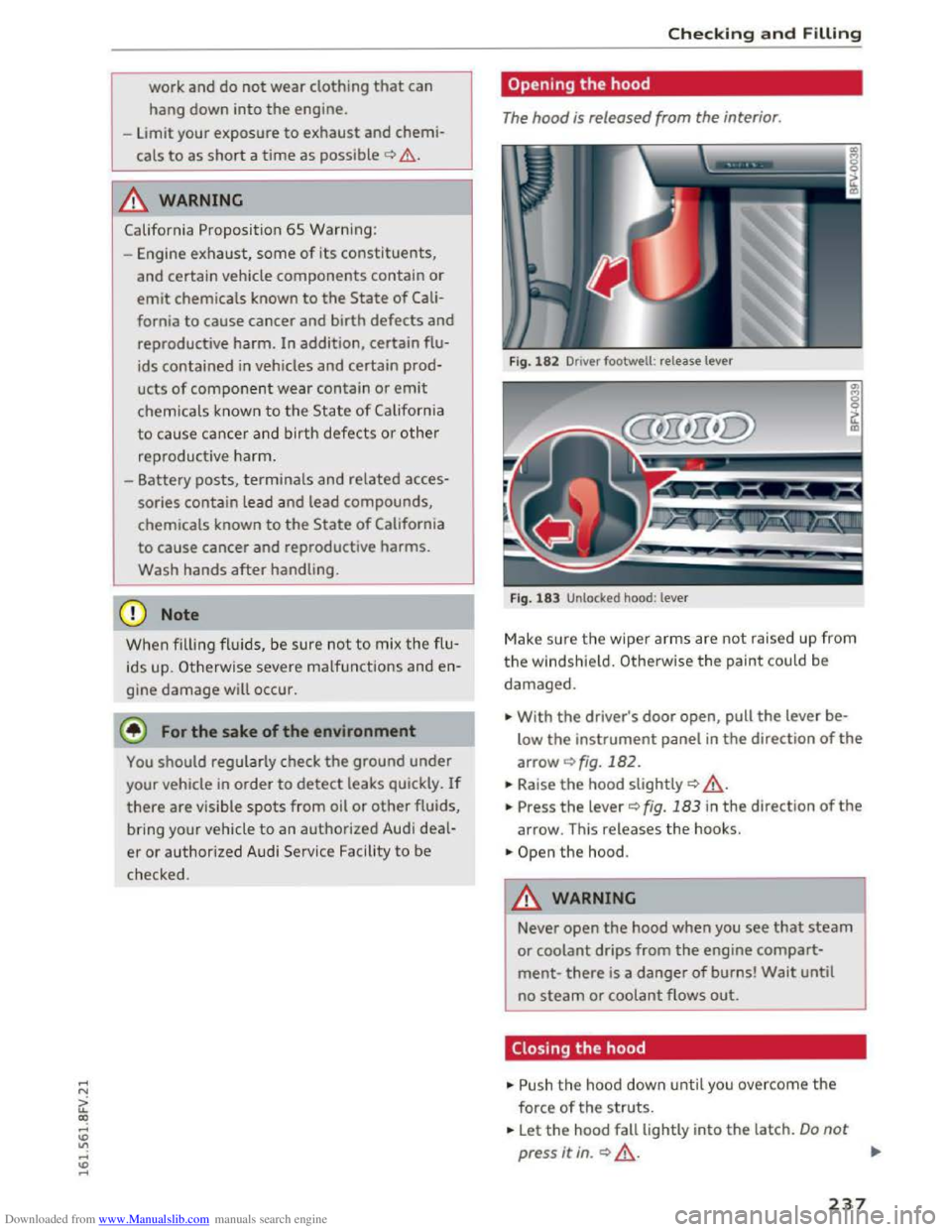
Downloaded from www.Manualslib.com manuals search engine work and do not wear clothing that can
hang down into the engine.
-Limit your exposure to exhaust and chemi
cals to as short a time as possible c::> &..
/Jj._ WARNING
California Proposition 65 Warning:
- Engine
exhaust, some of its constituents,
and certain vehicle components contain or
emit chemicals known to the State of Cali
fornia to cause cancer and birth defects and
reproductive harm. In addition, certain flu
ids
contained in vehicles and certain prod
ucts of component wear contain or emit
chemicals known to the State of California
to cause cancer and birth defects or other
reproductive harm.
-Battery posts, terminals and related acces
sories contain lead
and lead compounds,
chemicals known to the State of California
to cause cancer and reproductive harms.
Wash hands after handling.
CD Note
When filling fluids, be sure not to mix the flu
ids up.
Otherwise severe malfunctions and en
gine damage will occur.
@ For the sake of the environment
You should regularly check the ground under
your vehicle in order to detect leaks quickly. If
there are visible spots from oil or other fluids,
bring your vehicle
to an authorized Audi deal
er or authorized Audi Service Facility to be
checked.
Checking and Filling
Opening the hood
The hood is released from the interior.
Fig. 182 Driver footwell : release lever
Fig.
183 Unlocked hood: lever
Make sure the wiper arms are not raised up from
the windsh ield. Otherwise the paint could be
damaged.
... With the driver's door open, pull the lever be
low the instrument panel in the direction of the
arrowc::>fig.182 .
... Raise the hood slightly c::> ,&.
... Press the lever c::>fig. 183 in the direction of the
arrow. This releases the hooks.
.. Open the hood.
.&. WARNING
Never open the hood when you see that steam
or coolant drips from the engine compart
ment-there is a danger of burns! Wait until
no steam or coolant flows out.
Closing the hood
.. Push the hood down until you overcome the
force of the struts .
... Let the hood fall lightly into the latch. Do not
press it in. c::> ,&. ...
237
Page 240 of 322
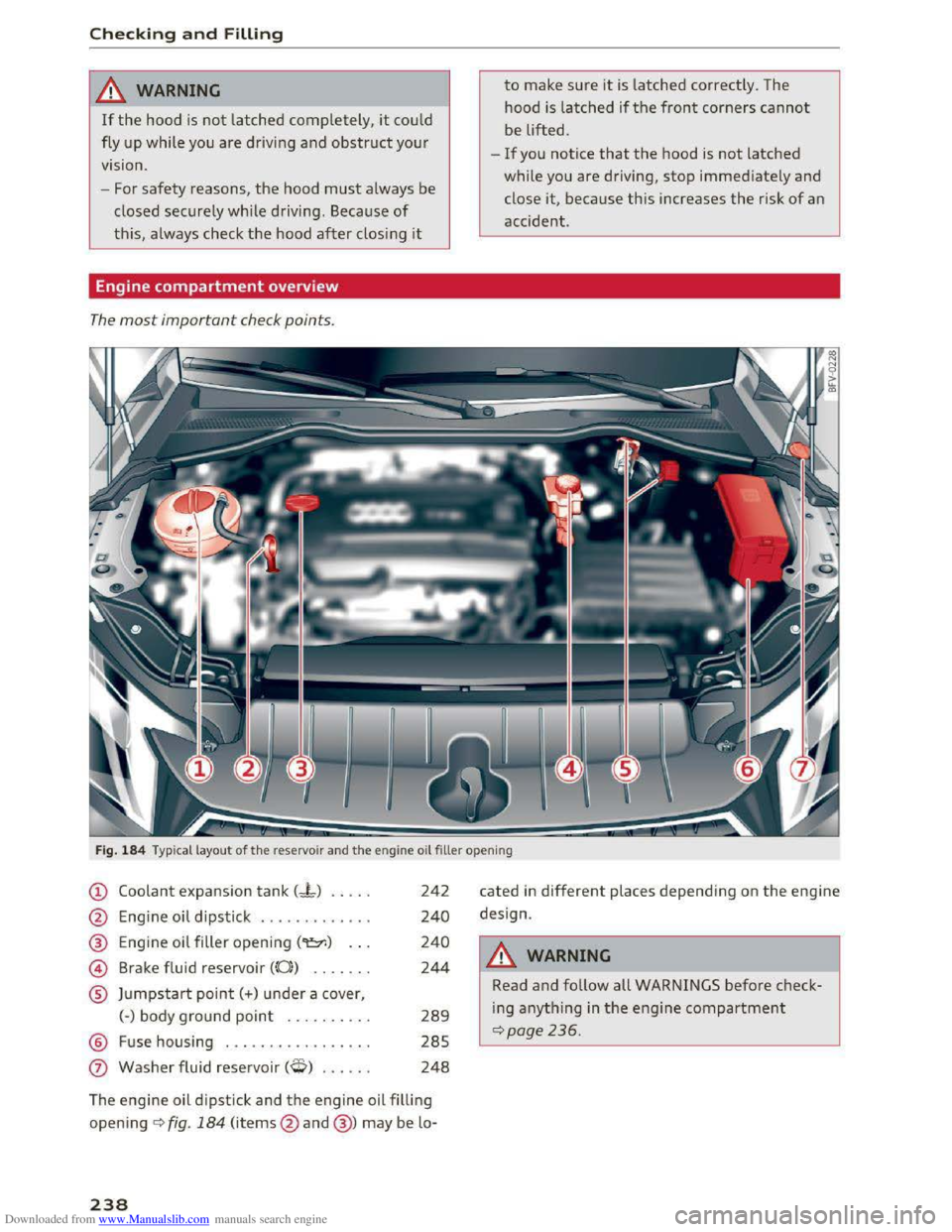
Downloaded from www.Manualslib.com manuals search engine Checking and Filling
& WARNING
If the hood is not latched completely , it could
fly up while you are driving and obstruct your
vision.
- For safety reasons,
the hood must always be
closed securely while driving. Because of
this, always check the hood after closing it
Engine compartment overview
The most important check points.
to make sure it is latched correctly. The
hood is latched
if the front corners cannot
be
lifted.
-If you notice that the hood is not latched
while you are driving, stop immediately and
close
it, because this increases the risk of an
accident .
Fig. 184 Typical layout of the reservo ir and the en gin e oil filler open ing
CD Coolant expansion tank C-t) .... .
@ Engine oil dipstick ............ .
@ Engine oil filler opening ("t:::r.) .. .
@ Brake fluid reservoir ((0)) ...... .
® Jumpstart point(+) unde r a cover,
(-)body ground point ......... .
@ Fuse housing ................ .
0 Washer fluid reservoir (W) ..... .
242
240
240
244
289
285
248
The engine oil dipstick and the engine oil filling
open ing <=>fig. 184 (items @ and @) may be lo-
238
cated in different places depending on the engine
design.
_&WARNING
Read and follow all WARNINGS before check
ing anything in the engine compartment
~page236.
Page 244 of 322
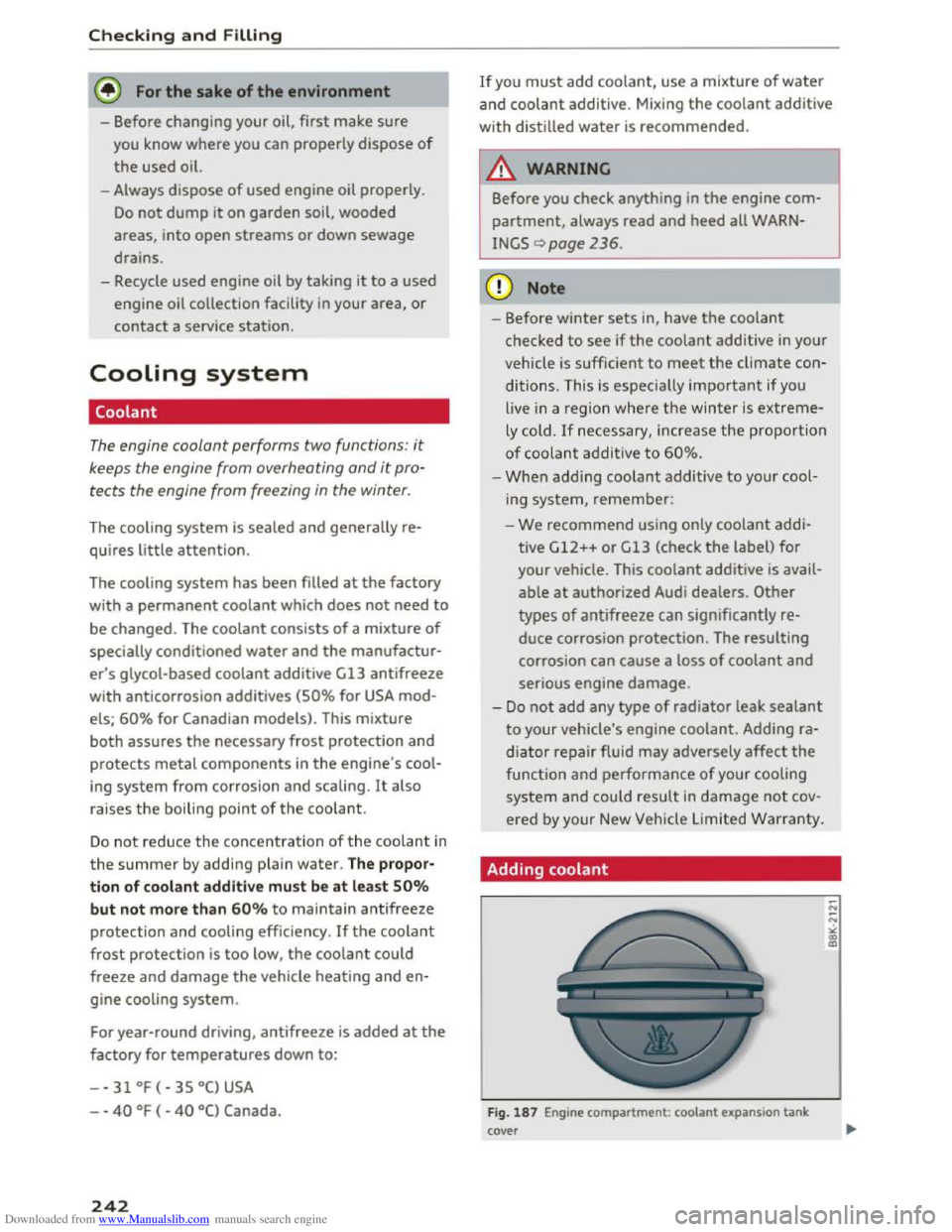
Downloaded from www.Manualslib.com manuals search engine Checking and Filling
@) For the sake of the environment
-Before changing your oil, first make sure
you know where you can properly dispose of
the used oil.
- Always
dispose of used engine oil properly.
Do not dump it on garden soil, wooded
areas, into open streams or down sewage
drains.
- Recycle
used engine oil by taking it to a used
engine oil collection facility in your area, or
contact a service station.
Coo Ling system
Coolant
The engine coolant performs two functions: it
keeps
the engine from overheating and it pro
tects the engine from freezing in the winter.
The cooling system is sealed and generally re
q uires
little attention.
The cooling
system has been filled at the factory
with a
permanent coolant which does not need to
be changed. The coolant consists of a mixture of
specially conditioned water and the manufactur
er's glycol-based coolant additive G13 antifreeze
with anticorrosion additives (50% for USA mod
els; 60% for Canadian models). This mixture
both assures the necessary frost protection and
protects metal components in the engine's cool
ing
system from corrosion and scaling. It also
raises
the boiling point of the coolant.
Do not reduce the concentrat ion of the coolant in
the summer by addi ng p la in water. The propor
tion of coolant additive must be at least 50°/o
but not more than 60°/o to maintain antifreeze
protection and cooling efficiency. If the coolant
frost protection is too low, the coolant could
freeze and damage the vehicle heating and en
gine cooling system.
For year-round driving,
antifreeze is added at the
factory for temperatures down to:
- -
31 °F ( -35 °C) USA
- -40 °F ( -40 °C) Canada.
242
If you must add coolant, use a mixture of water
and coolant additive. Mixing the coolant additive
with distilled
water is recommended.
A WARNING
~ h . Before you check anything in t e engine com-
partment, always read and heed all WARN
INGS C)page 236.
CD Note
-Before winter sets in, have the coo lant
checked to see if the coolant additive in you r
vehicle is
sufficient to meet the climate con
d itions. This is especia l
ly important if you
live
in a regio n where the winter is extre m e
ly cold . If necessary, increase the proportion
o f coo la
nt ad ditive to 60o/o.
-When add ing coolant additive to your cool
ing
system, remember:
-We recommend using only coolant addi
tive G12++
or G13 (check the label) for
your vehicle. This coolant additive is avail
able at authorized Audi dealers. Other
types of antifreeze can significantly re
duce corrosion protection. The resulting
corrosion can cause a loss of coolant and
serious engine damage.
-Do not add any type of radiator leak sealant
to your vehicle's engine coolant. Adding ra
dia to r repair fluid may adversely
affect the
func tion and performance of your cooling
system and could result in damage not cov
ered by your New Veh icle Limited W arranty .
Adding coolant
Fig. 187 Engine compartment : coolant expansion tank
cover
Page 245 of 322

Downloaded from www.Manualslib.com manuals search engine ...... N
> u. CX> ...... u:>
"' ...... u:> ......
Read and follow the WARNINGS before check
ing anything
in the engine compartment
Qpage236.
Checking the engine coolant level
""Park your vehicle on a level surface.
"" switch the ignition off.
.. Read the coolant level on the coolant expansion
tank
Q page 238, fig. 184. The coolant level
must be between the markings when the en
gine
in cold. When the engine is warm it can be
slightly above
the upper marking.
Adding coolant
Requirement: there must be a res idual amount of
coo l
ant in the expans io n tank c:?(i) .
""Let the engine cool down.
.. Place a cloth over the coolant expansion tank
cap and unscrew
the cap counterclockwise
c:?,8..
""Add coolant mixed in the correct ratio
i:?page 242 up to the upper marking.
""Make sure that the fluid level remains stable.
Add more coolant if necessary.
"" Close the cap securely .
A coolant loss suggests a leak. Immediately drive
your vehicle
to an authorized Audi dealer or au
thorized
Audi Service Facility and have the cool
ing system inspected.
If the cooling system is not
leaking, a loss can come from
the coolant boiling
through overheating and being pushed
out of the
cooling system.
.&. WARNING
-The cooling system is pressurized and can be-
come very hot.
To reduce the risk of burns
from hot coolant:
-
Do not open the coolant expansion tank cap
w ith
the engine hot. There is a risk of burns .
- Stop
the engine and allow it to cool.
-
Protect your face, hands and arms from es-
caping coolant and
steam by covering the
coolant tank cap with a large, thick cloth.
- Turn
the coolant tank cap counterclockwise
slowly and keep light pressure on
the cap.
-
To reduce the risk of burns, do not allow any
antifreeze or coolant to dr
ip onto the ex-
Checking and Filling
ha ust system or hot engine components.
The ethylene glycol in engine coolant can
catch fire under certain circumstances.
- The coolant additive and the coolant can be
dangerous to your health.
For this reason,
keep
the coolant in the original container
away from children. There is a
risk of poi
soning.
-When working in the engine compartment,
remember
that the radiator fan can switch
on even if
the ignition is switched off, which
increases
the risk of personal injury.
CD Note
Do not add coolant if the expans ion tank is
empty . Air could enter the cooling system and
damage
the eng ine. If this is the case, do not
continu e driving. See an authorized
Audi dea l
er or authorized
Audi Service Facility for assis
tance.
Radiator fan
The radiator fan switches on automatically by it
self.
An auxiliary electric radiator fan switches on and
off depending on coolant temperature and other
vehicle operating conditions.
After you switch
the engine off, the auxiliary fan
can continue running for
up to 10 minutes -even
with
the ignit ion off. It can even switch on again
later by itself c:? & . if
- the temperature of
the engine coolant rises due
to
the heat build-up from the engine in the en
gine compartment, or
-
the engi ne compartment heats up because the
vehicle is parked in intense sunlight.
.&. WARNING
-To reduce the risk of personal injury never
touch
the radiator fan.
- The auxiliary electric fan
is temperature
controlled and can switch on suddenly even
when
the engine is not running.
243
Page 246 of 322
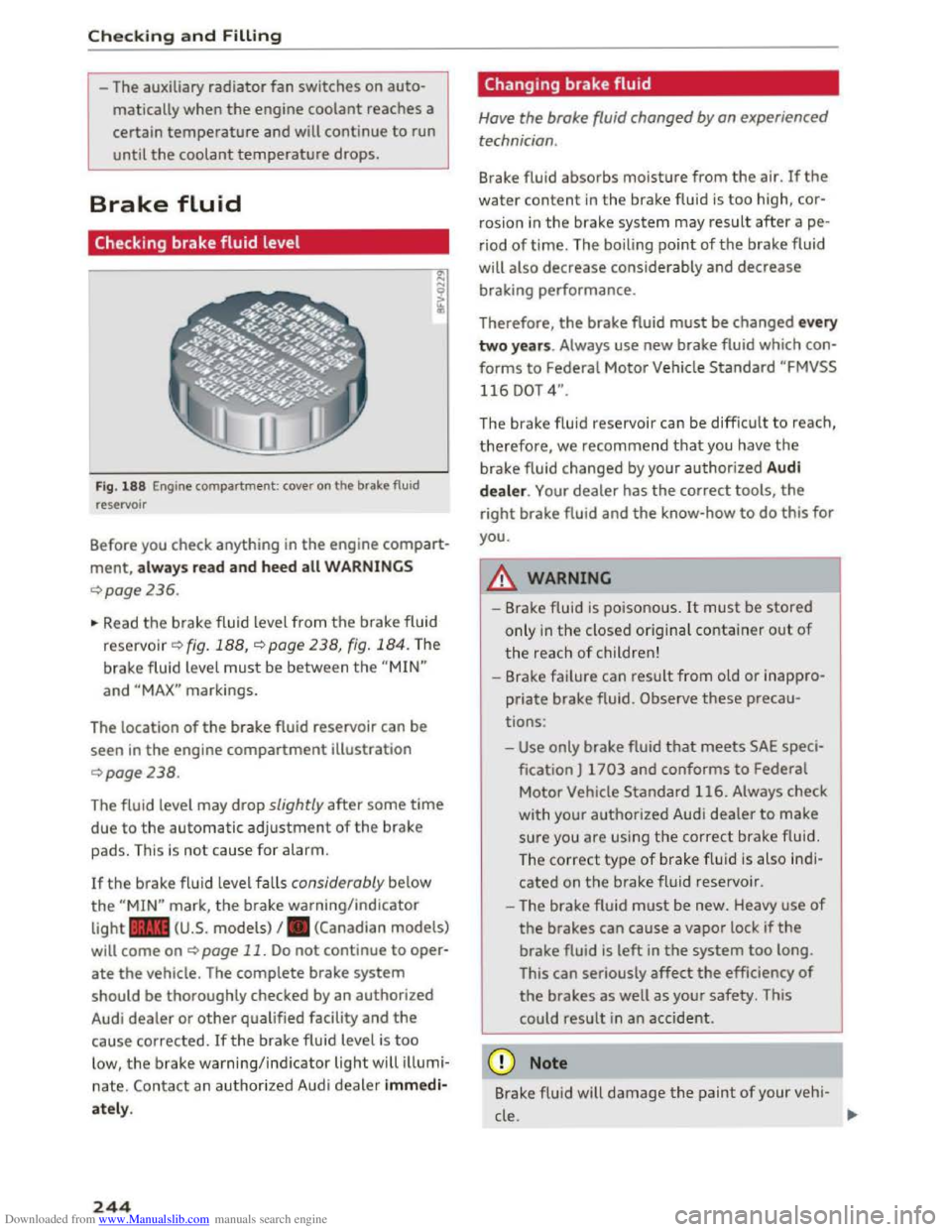
Downloaded from www.Manualslib.com manuals search engine Checking and Filling
-The auxiliary radiator fan switches on auto
matically when the engine coolant reaches a
certain temperature and will continue to run
until the coolant temperature drops.
Brake fluid
Checking brake fluid level
Fig. 188 Engine compartment: cover on the brake fluid
reservoir
Before you check anything in the engine compart
ment, always read and heed all WARNINGS
¢page 236.
~ Read the brake fluid level from the brake fluid
reservo ir ¢ fig. 188, ¢page 238, fig. 184. The
brake fluid level must be between the "MIN"
and "MAX" markings.
The location
of the brake fluid reservoir can be
seen in the engine compartment illustration
¢page238.
The fluid level may drop slightly after some time
due to the automatic adjustment of the brake
pads. This is not cause for alarm.
If the brake fluid level falls considerably below
the "MIN" mark, the brake warning/indicator
light .. (U.S. models) I. (Canadian models)
will come on ¢ page 11. Do not continue to oper
ate the vehicle. The complete brake system
should be thoroughly checked by an authorized
Audi dealer or other qualified facility and the
cause corrected. Ifthe brake fluid level is too
low, the brake warning/indicator light will illumi
nate. Contact an authorized Audi dealer immedi
ately.
244
Changing brake fluid
Have the brake fluid changed by an experienced
technician .
Brake fluid absorbs moisture from the air. If the
water content in the brake fluid is too high, cor
rosion in
the brake system may result after ape
riod of time. The boiling point of the brake fluid
will
also decrease considerably and decrease
braking performance.
Therefore, the brake fluid must be changed every
two years. Always use new brake fluid which con
forms to Federal Motor Vehicle Standard "FMVSS
116 DOT 4".
The brake fluid reservoir can be difficult to reach,
therefore, we recommend that you have the
brake fluid changed by your authorized Audi
dealer. Your dealer has the correct tools, the
right brake fluid and the know-how to do this for
you.
8._ WARNING
- Brake fluid is poisonous. It must be stored
only in the closed original container out of
the reach of children!
-Brake failure can result from old or inappro
priate brake fluid. Observe these precau
tions:
-Use only brake fluid that meets SAE speci
fication
J 1703 and conforms to Federal
Motor Vehicle Standard 116. Always check
with
your authorized Audi dealer to make
sure you are using the correct brake fluid.
The
correct type of brake f lui d is also ind i
cated on the brake fluid reservoir .
- The
brake fluid must be new. Heavy use of
the brakes can cause a vapor lock if the
brake fluid is left in the system too long.
This
can seriously affect the efficiency of
the brakes as well as your safety. This
could
result in an accident.
CD Note
Brake flu id will damage the paint of your veh i-
cle .
JIJ.
Page 255 of 322

Downloaded from www.Manualslib.com manuals search engine reinforced by ply cords and that is
shaped to fit the rim.
Bead separation
means a breakdown of the bond
between components in the bead.
Cord
means the strands forming the
plies in the tire.
Cold tire inflation pressure
means the tire pressure recom
mended by the vehicle manufac
turer for a tire of a designated
size that has not been driven for
more than a couple of miles (kilo
meters) at low speeds in the
three hour period before the tire
pressure is measured or adjusted.
Curb weight
means the weight of a motor ve
hic le
with standard equipment in
c l
uding the maximum capacity of
fuel, oil, and coolant, air condi
tioning and additional weight of
optional equipment.
Extra load ti re
means a tire designed to operate
at higher loads and at higher in
flation pressures than the corre
sponding standard tire. Extra load
tires may be identified as "XL ",
Wheels
"xl" "EXTRA LOAD" or "RF" on , ,
the sidewall.
Gross Axle Weight Rating
("GAWR")
means the load-carrying capacity
of a single axle system, measured
at the tire-ground interfaces.
Gross Vehicle Weight Rating
(" GVWR ")
means the maximum total loaded
weight of the vehic le.
Groove
means the space between two ad
jacent tread ribs.
Load rating (code)
means the maxim um load that a
tire is rated to carry for a g iven in
flation pressure. You may not find
this information on all tires be
ca use it is not required by law.
Maximum load rating
means the load rating for a tire at
the maximum permissible infla
tion pressure for that tire.
Ma ximum loaded vehicle
weight
means the sum of:
(a)
Curb weight
(b) Accessory weight
253